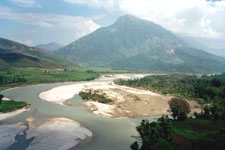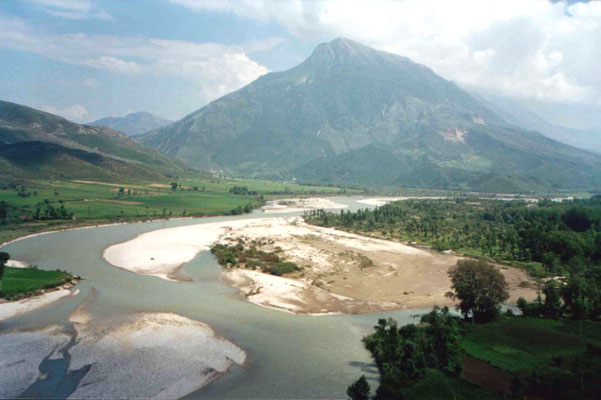| | Robert Elsie | AL Art | AL History | AL Language | AL Literature | AL Photography | Contact | |
Robert Elsie
Texts and Documents of Albanian History
BACK | AL History

The Vjosa River near Tepelena
(Photo: Robert Elsie).
1154
Muhammad al-Idrisi:
The Book of Roger
Muhammed al-Idrisi was a celebrated Arab geographer. He was born in Ceuta in North Africa and is said to have studied in Cordoba, travelling widely throughout Andalusia and North Africa. For reasons which are unclear, he settled at the court of King Roger II of Sicily (r. 1105-1154), for whom he compiled a geography of the known world. This work, known as the 'Book of Roger', is divided into seven climate zones. It was completed in 1154 and provides some useful information on Albania and Macedonia.
We can state that Venetian territory, the land of the Slavs and, in general, everything bathed by the Adriatic Sea is surrounded as a zone on the eastern side by a chain of mountains which begins 30 miles from Adrianople (Edirne). These mountains are called Lessû (Lezha) and at the top of them there is a town of the same name. They stretch northwards up to Kastoria and there is also a chain of them across from Drast (Durrës) through which the road leading to that town and elsewhere passes. There, the mountain range is called al-Tamûra (Tomor). Three rivers which flow towards Lablûna (Vlora) and Durrës take their sources there. The first river, that of Vlora, is called the Shuzza (Vjosa), the second is called the Dâblî (Devoll) and the third is called Istrîna (Drin). This chain then stretches from the Durrës road 40 miles up to Jâdhra (Zadar). From the point nearest to Adrianople and the town of Janina there is a mountain range which stretches to the gulf of the Peloponnesian Sea and ends 80 miles from Thebes. Naupaktos is on the coast at the foot of this range.
As to the mountain of Lezha, to which we have referred, it is situated 15 miles from Durrës. It is 30 miles from the town of Lezha to Duljîna (Ulcinj) on the Adriatic Sea. And from there to the mountain it is 12 miles.
This mountain range stretches firstly to near Antibra (Bar), a fair town built on a hillside 3 miles from the sea, as is the mountain; secondly to Qadara (Kotor), a place situated 3 miles from the mountains at the edge of one of the mountain ranges; and thirdly to the town of Ragusa (Dubrovnik), which is also situated at the edge of the mountains.
Across from the town of Kotor, of which we have spoken, and beyond the mountains at a distance of 15 miles is Qâmyû (1), a flourishing town situated near a range of mountains which surrounds it in the form of a kâf (2) such that one can only reach it from one side.
The mountain range continues towards Stagno (Ston) where a huge and lofty range stands out, on which the town is situated. Then on to Asbâlatû (Split)...
Between the Adriatic Sea and the straits of Constantinople there are numerous famed sites, towns and capitals. We intend, with the help of God, to refer to them in detail and in order. As such, we say that the road from Durrës to Akhrisopoli (Chrysoupolis) is as follows.
From Durrës on the banks of the Adriatic Sea, journeying by land in the direction of Constantinople, one first of all reaches Petrela, situated on a promontory at a distance of two days. From there, it is a distance of 4 days to Okhrida (Ohrid). This town is remarkable as to the significance of its prosperity and its commerce. It is built on a pleasant promontory not far from a large lake where they fish on boats. There is much cultivated land around the lake, which is to the south of the town. Its circumference is slightly more than 3 days.
It is a distance of 2 days from here to Bûlghû (Polog / Tetovo), a fair town situated on the summit of a lofty mountain. At one day's distance from here, travelling to the northeast, is Asqûfia (Skopje), a large town surrounded by contiguous cultivated land, by many vineyards and field.
(1) Unidentified.
(2) 22nd letter of the Arabic alphabet.[Extract from: H. Bresc & A. Nef (ed.): Idrîsî, la première géographie de l'Occident, Paris 1999, p. 401-403; and E. Cerulli, F. Gabrieli, G. Levi della Vida, L. Petech, G. Tucci (ed.): Al-Idrisi, Opus Geographicum, Fasc. V, Naples & Rome 1975, p. 792-793. Translated by Robert Elsie. First published in R. Elsie: Early Albania, a Reader of Historical Texts, 11th - 17th Centuries, Wiesbaden 2003, p. 21-22.]
TOP
